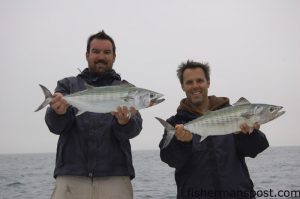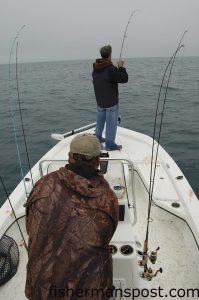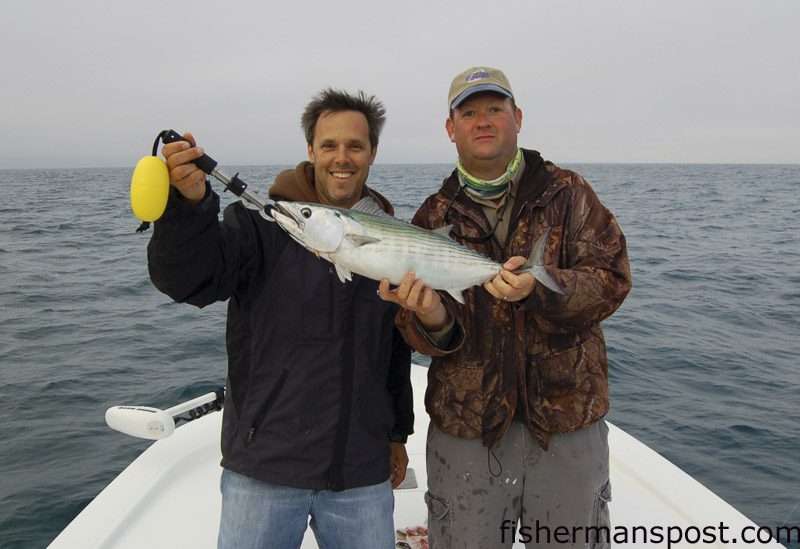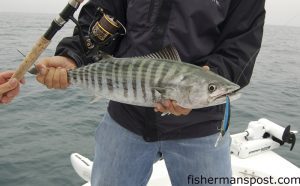Bait, Birds, Bonito

Max Gaspeny and Gary Hurley with a pair of Atlantic bonito that struck silver/gold diamond jigs in 30’ of water a short distance off New River Inlet while they were fishing with Capt. Daniel Jarvis of Flat Foot Charters out of Topsail Island.
A gray dawn greeted us at New River Inlet as Capt. Daniel Jarvis eased back the throttle to glide his 21’ Frontier bay boat over the early chop in the inlet channel. The sun added a little warmth to a surprisingly chilly April morning, and as the sole member of our crew who’d worn shorts, I can’t say I wasn’t glad.
Always eager to take advantage of the brief spring appearance of Atlantic bonito off our coast, I leapt at the opportunity when Daniel called to say the fish had arrived in earnest. Joining me per usual was Fisherman’s Post Publisher Gary Hurley, who was eager to take advantage of any opportunity to fish with the delivery of his third son an imminent force on the horizon.
The waves spaced out a bit as we neared the sea buoy, and Daniel swung the Frontier’s bow to the east, popping the boat on plane for a short ride to where the fish had been earlier in the week.
“We caught the bonito much better trolling than casting on the last trip,” Jarvis explained after slowing down, “so that’s what we’re going to start out doing while we look for birds.”
The captain drew a pair of rods from his console rigged with Yo-Zuri Deep Diver Crystal Minnow plugs, his number one trolling lure for the speedy little nearshore tuna/mackerel relatives.
“I like these because they run very true right out of the box and they’ve got more flash than just about any other lure,” Jarvis said as we deployed the baits on each side of the wake. “I troll just fast enough to keep them from popping out of the water.”
The outfit’s tips were soon vibrating steadily with the swimming action of the little lures, and we continued our track to the east inshore of Divers Rock, a live and hardbottom area a few miles off the New River sea buoy.
“That guy’s right on where we found them earlier in the week,” Jarvis explained, motioning at a bay boat a quarter mile off his port bow. “They were here inshore and not out at Divers for some reason.”
A quick gesture to his chartplotter confirmed it, as the black line of his previous trip’s track revealed repeated circling passes over the area in question.
“We’ll stay off him a little bit though,” Jarvis continued steering wide of the other anglers. “You guys keep your eyes open for those birds now.”
Gary and I kept peeled eyes out for the avian fish finders, but low, dark clouds made spotting the distant birds difficult, and the few in plain sight appeared to be engaged in the same hunt we were.
“There’s the bait,” Jarvis exclaimed, indicating a ragged red blob on the sounder screen. “Even when they’re not feeding on top, if you find the bait, the bonito are nearby.”
He barely had a chance to get the words out before the starboard rod started bucking and a Penn Battle 4000 spinning reel broke into a sweet drag song. As I was on the same side of the boat, I happily pulled the outfit from the holder and let the fish burn off some steam (and line).
With the exception of a nearshore king mackerel, not much that lives this close to a North Carolina beach can run with the screaming urgency of a bonito, and this fish left no doubt as to its species, making the spinner wail for a solid 20-30 seconds before it slowed.

Gary Hurley battles an Atlantic bonito that struck a Yo-Zuri Crystal Minnow Deep Diver in 25' of water inshore of Diver's Rock.
In another signature move, the fish capped the searing run off with an abrupt U-turn, doubling back toward the boat as I reeled frantically in an attempt to keep up.
Though the fish tried valiantly, the slack line didn’t get the best of me, and the hard bend in the rod and the again-squealing reel signified that my adversary had suddenly decided on a fresh direction.
The drag was taking its toll on the fish, however, and this second run didn’t sap all the line I’d managed to gain while the fish charged the boat.
The fish pulled off a few more line-ripping bursts, but the drag’s pressure soon took its toll and the fight took on a new character, as I struggled to gain line while it circled stubbornly under the boat. Daniel grabbed a landing net while I pressured the fish upward, but it seemed to regain a little strength as he reached over the gunnel. Now plainly visible in the clear green water, it tore off a few more yards of line when Daniel stretched out with the net. The scenario replayed itself a few times, as the bonito seemed to sense the exact perimeter of the captain’s reach, staying just out of range until a final miscalculation left it flopping in the net’s rubber mesh bag.
“Alright Daniel!” Gary exclaimed, pulling out the camera to get a few shots of the Deep Diver hanging from the tired fish’s mouth. “What’d that take, three minutes of trolling?” he added with a grin.
The Atlantic bonito’s fighting ability is easily matched by its beauty, and I examined the prize while cradling it for the photo, its green, horizontally striped back crosshatched by a set of ephemeral vertical bars not unlike a lit-up wahoo’s. Oh yeah, they’re delicious, too, rivaling other members of the tuna family on the grill, and the fish was shortly thereafter dispatched to a cooler to await a brief searing on a hot gas grill.
Thrilled to have the target species on ice so quickly, we sent the Deep Divers back to work, but the game plan was about to change.
“Look!” Daniel exclaimed, pointing ahead and slightly offshore. “They’re hitting it over there, reel them up!”
A few hundred yards off the bow, a dozen or so terns and gulls wheeled and dipped to the sea as the surface was pocked with explosive splashes from the feeding bonito.
We got the trolling plugs in in triple-time and each grabbed one of the similar outfits rigged with silver/gold diamond jigs that Daniel offered up from the console holders while mashing the throttle to close the gap between us and the melee.
The bonito were still on the surface when we arrived, and Gary and I fired simultaneous casts toward the feeding fish. Two other boats had beaten us there, however, and the churning ocean had diminished to a few isolated splashes by the time our jigs hit the water.
The activity ceased altogether by the time we’d retrieved the lures, biteless, and Daniel told us to hold off on a follow-up cast.
“I think they’ve got these fish covered,” he said, scanning for, and then finding, another group of wheeling seabirds. “See them! Let’s go!”
The captain gassed us a few hundred yards from the fellow anglers, where more bonito and birds conspired to make life tough for a school of defenseless glass minnows.
“Right there!” Daniel exhorted as the boat glided off plane. “They’re still poppin’. You boys ought to hook up in no time!”

Fisherman's Post Publisher Gary Hurley and Capt. Daniel Jarvis, of Flat Foot Charters, cradle an Atlantic bonito that struck a gold/silver diamond jig in 30' of water off New River Inlet.
Again launching the jigs at the agitated ocean, Gary made Daniel an honest man within a few turns of the reel handle, another Penn Battle’s drag squealing to life in his hands. I managed to get my jig back to the boat without a strike and fired another long cast as Gary’s fish poured on the speed. Another pair of boats had made their way over, though, and the school had gone down. Allowing my jig to sink deep in the hopes that it would find another bonito low in the water column, I was rewarded with a bite, but not the screaming run I was looking for.
I quickly battled a 2 lb. class bluefish to the surface, allowing it to conveniently unhook itself boatside, then set the rod down. The fish had moved on from our immediate vicinity, so I grabbed a camera and tried to get some interesting action shots of the boss fighting the bonito. Gary’s fish didn’t give back the line as easily as mine had, doggedly fighting it out after a long run instead of zipping back towards us. It also apparently reserved more energy for the endgame, too, as it played the just-out-of-reach card nearly a dozen times before finally submitting to the landing net and a grinning Gary Hurley.
This fish joined the first on the ice after some quick photos, and we began scanning for more working birds and another school of feeding fish. The birds were a little scarcer than usual, and made up mostly of smaller terns and gulls instead of larger seabirds.
“There were pelicans working them over yesterday,” Daniel explained as we gunned it for another promising batch of feeding activity. “It looked like somebody dropping depth charges in the water. They make it easy.”
Like the birds, the bonito seemed a bit shy this morning, and instead of big schools of fish slashing the water, smaller groups of a half-dozen or so splashes were the rule. Boats heading for the commotion quickly sent the fish deep, despite the fact that the overcast day had led to a less-than-typical crowd looking for the fish and most boats were being relatively mindful to not run the fish over, instead staying a cast-length away from the action.
We ran to a few small groups of fish without hooking up again before Daniel saw what he was looking for.
“Good Lord, that’s what I’m talking about right there!” he said, piloting us toward the first relatively large school of surfacing fish we’d seen that morning. “Let’s get upwind and let the breeze take us to the fish.”
“Hopefully these other guys will do the same,” he added as several other boats raced for us. “I don’t mind sharing, but some of these people will just run right through the school and put them down.”
This time, the fish stayed active as Gary and I arced the diamond jigs a healthy distance downwind. We’d scarcely had time to flip the reel’s bails over before we were both hooked up.
Glancing at each other, then the captain, we rejoiced in the double header.
“That’s what bonito fishing is about, boys,” Daniel said as our fish took off, flirting with fouling us on a nearby boat before finding open water and turning on the tuna speed. Mine proved more stubborn than Gary’s, and as it turned out, it was because I was fighting another angler as well as the fish.
Fisherman’s Post friends Michelle and Capt. Wayne Crisco were out getting in on the action, too, and Michelle’s line had snared mine when the fish shot by their boat. After a brief and jovial repartee over whose fish in fact it was, Wayne quickly unhooked his wife’s jig from my line and left me to the battle.
Fishing in close proximity to other boats is a fact of life when the bonito show up outside New River Inlet, and most anglers manage to fish side-by-side in harmony like Wayne and Daniel, but discourteous behavior like running over the feeding fish and not expediently taking care of the inevitable crossed lines will turn potential friends into enemies in a hurry.
Daniel had already scooped up Gary’s fish and I endured a little ribbing about coddling mine before I was able to bring it to net, but we soon had the concrete proof of the doubleheader on deck, took a quick photo, and went back to looking for birds.
What few we saw were cruising again instead of feeding, and Daniel quickly made the call to adjust our strategy.
“Let’s go back to trolling unless we see them up top again,” the captain said, trading us the casting rods for the pair rigged with Deep Divers.
We put the spread back out, and I broke out the chicken sandwich I’d brought along, ready to replenish a few of the calories I’d burnt fighting bonito. Of course, I’d barely managed to bite through the bread’s crust when both rods went down and we found ourselves again battling a bonito doubleheader. Mine pulled the hooks, but Gary put another one of the beautiful fish in the boat.

This Atlantic bonito couldn't resist a Yo-Zuri Deep Diver trolled through some bait marks off New River Inlet.
Back on the troll, we experienced continued and fast action that didn’t leave much time for eating. I’d like to blame the sandwich, as I’d never manage to chew more than a few mouthfuls before the rods bent over again, but the reality was that we were just getting bites every minute or so, and I don’t think the chicken breast had much to do with it.
We continued trolling, decking spanish mackerel and bluefish along with the bonitos, before deciding to call it an early trip and get back to Wilmington so Gary could continue trying to get as many teaching and Fish Post chores as possible taken care of before getting the call to head for the delivery room.
For those who haven’t experienced it, an Atlantic bonito trip should be on any North Carolina angler’s to-do list. The action-packed light-tackle fishing for these delicious little predators is, in my opinion, some of the most exciting angling of the year, and the fish typically stick around until sometime in May. When they move on, Daniel focuses on his other specialties, putting clients on red and black drum, speckled trout, flounder, and more along the inshore waters from New River to Wrightsville Beach.
Give him a call to talk about a trip at (910) 805-4552 or check out www.flatfootfishingcharters.com for more information.





